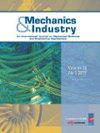ORES: a chassis dynamometer for off-road vehicles
IF 1.2
4区 工程技术
Q3 ENGINEERING, MECHANICAL
引用次数: 3
Abstract
Off-Road Environment Simulator (ORES) is a Real-time Hardware-in-the-Loop (RT-HIL) platform to simulate the dynamic response of off-road vehicles. This paper primarily focuses on the vehicle model development and validation using both field and rig testing using the ORES platform. Off-road vehicles are capable of operating on bumpy terrains where they are subjected to different resistive wheel torques due to non-unique ground friction conditions and wheel loads. If the powertrain torque output is not distributed in accordance with the resistive wheel torques, it may lead to transmission windup resulting in premature failure of various driveline components. In this study, the vehicle is driven over discrete bumps both in rig simulation and field trial. Different terrain enveloping models were evaluated namely the single point, radial-spring contact model and two-point follower (using circular and sinusoidal basis). These models were evaluated against the measured wheel acceleration responses. The two-point follower with sinusoidal basis strongly correlates with the measured responses and the ground excitations so obtained were used as inputs to a seven degree-of-freedom vehicle ride model. Ride model calculates the wheel loads and is eventually integrated with longitudinal dynamics, tire, driveline and test-rig models. Vehicle axle acceleration, wheel speed and drive torque responses are measured for validating the simulation results against field and rig trials. The field responses matches fairly well which validates the suitability of the proposed modeling approach.ORES:用于越野车辆的底盘测功机
越野环境模拟器(ORES)是一个实时仿真越野车辆动态响应的硬件在环(RT-HIL)平台。本文主要侧重于使用ORES平台进行现场和钻机测试的车辆模型开发和验证。由于非独特的地面摩擦条件和车轮载荷,越野车能够在颠簸的地形上运行,在那里它们受到不同的车轮阻力扭矩。如果动力总成扭矩输出与阻力轮扭矩分配不一致,可能会导致变速器绕组,导致各传动系统部件过早失效。在本研究中,车辆在钻机模拟和现场试验中行驶在离散的颠簸上。评估了不同的地形包络模型,即单点、径向弹簧接触模型和两点从动器(使用圆形和正弦基)。根据测量的车轮加速度响应对这些模型进行了评估。基于正弦基的两点从动器与实测响应密切相关,并将由此得到的地面激励作为七自由度车辆平顺性模型的输入。Ride模型计算车轮载荷,并最终与纵向动力学、轮胎、传动系统和试验台模型集成。通过测量车辆轴加速度、车轮速度和驱动扭矩响应,通过现场和钻机试验验证仿真结果。现场响应匹配较好,验证了所提建模方法的适用性。
本文章由计算机程序翻译,如有差异,请以英文原文为准。
求助全文
约1分钟内获得全文
求助全文
来源期刊

Mechanics & Industry
ENGINEERING, MECHANICAL-MECHANICS
CiteScore
2.80
自引率
0.00%
发文量
25
审稿时长
>12 weeks
期刊介绍:
An International Journal on Mechanical Sciences and Engineering Applications
With papers from industry, Research and Development departments and academic institutions, this journal acts as an interface between research and industry, coordinating and disseminating scientific and technical mechanical research in relation to industrial activities.
Targeted readers are technicians, engineers, executives, researchers, and teachers who are working in industrial companies as managers or in Research and Development departments, technical centres, laboratories, universities, technical and engineering schools. The journal is an AFM (Association Française de Mécanique) publication.
 求助内容:
求助内容: 应助结果提醒方式:
应助结果提醒方式:


